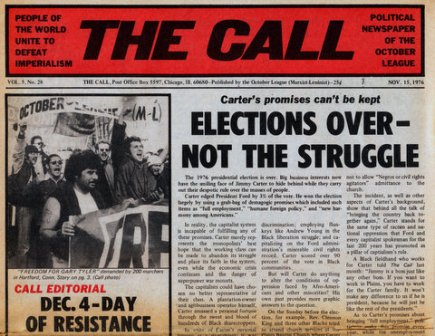
First Published: The Call, Vol. 5, No. 28, November 15, 1976.
Transcription, Editing and Markup: Paul Saba
Copyright: This work is in the Public Domain under the Creative Commons Common Deed. You can freely copy, distribute and display this work; as well as make derivative and commercial works. Please credit the Encyclopedia of Anti-Revisionism On-Line as your source, include the url to this work, and note any of the transcribers, editors & proofreaders above.
Recent celebrations of The Call’s fourth anniversary have been highly successful in recruiting new correspondents for the paper, raising the thousands of dollars needed to expand our work and enlisting several hundred new subscribers.
The programs – held in about a dozen cities – were also important in summing up the role which a communist newspaper must play in this period as collective agitator, organizer and propagandist for the workers’ movement.
At the Detroit forum, W. Jean-Pierre spoke on the question of The Call’s role in bringing about Marxist-Leninist unity. Jean-Pierre, a former leader of both the Black Workers Congress and the Revolutionary Workers Congress, has been an active supporter of the Organizing Committee for a Marxist-Leninist Party (OC) and its party-building efforts. Below, we reprint excerpts from the speech.
* * *
It was through The Call that many Marxist-Leninists from different organizations and experiences came together. First, through the “Call to Unite” in Nov. 75 and, secondly, through The Call for the May Unity Meeting in 1976. The Call thus became the medium of unity for many of us who were either members of small circles ’ or individuals who had dropped out of other organizations and had no contact with each other, and in many cases didn’t know each other existed. Through the pages of The Call, our desire for unity became an immediate and concrete thing.
Second, besides being a uniting element, The Call was our medium of struggle against anti-Marxist views and organizations. The various statements of unity which were written by members of the OC and printed in the pages of The Call struck a blow to the fomenters of sectarianism and revisionism and gave witness to the fact that unity was indeed the main and developing trend inside our movement. These unity statements, along with polemics conducted by the OL and others, hastened the downfall of groups like the “Revolutionary Wing,” the Guardian, and others.
In this way, The Call was a collective propagandist in the hands of the forces representing the unity trend in our movement.
Third, in addition to being a collective organizer and propagandist, The Call was our link to the masses, our collective agitator. The Call never separated party building from mass work. At the same time, as articles of unity and polemics were printed, day-to-day political exposures of people’s struggles against the capitalist system appeared in the pages of The Call.
In some articles, like those of the Gary Tyler struggle, the relation of party building to the mass movement was clearly and sharply presented. The success of this correct approach to propaganda and agitation was demonstrated remarkably at the recent party-building forum in Milwaukee where 50% of the people attending were activists in the struggle to free Gary Tyler.
Despite shortcomings, I believe The Call has rendered invaluable service to the whole communist and workers’ movement. In my view, it comes closest to the Iskra-type paper which Lenin developed for the Russian revolutionary movement.
This is so not only because The Call is national in scope, is printed in two languages, appears weekly and has a fairly large circulation, but even more importantly because it puts forward a Marxist-Leninist line and connects this line with the struggle of the masses. This is not wishful thinking on my part because I’ve seen how the workers have responded to The Call in my plant and other plants where it is sold. I know workers who have written articles for The Call and seen them wait anxiously for them to appear.
Unlike the “leftists,” who emphasize only propaganda, or the rightists, who emphasize only agitation, a communist newspaper must combine both propaganda and agitation. It must be a collective organizer. It is only through the genuine communist press, which is national in scale, appears regularly, and has a wide distribution, that a communist party based in the industrial working class can be built.
If you agree with most of what has been said here today, then let us use this occasion to strengthen and build The Call even more. Let us leave here with the determination to bring The Call to more and more workers and bring them into the work of making The Call a better, bigger workers’ paper than it is now. Let us dig deeper into our pockets and bring out that extra dollar to help finance The Call and expand its pages. By building The Call in this way, we are making at the same time, tremendous efforts towards building our party.
LONG LIVE THE CALL/EL CLARIN!
LONG LIVE THE FUTURE MARXIST-LENINIST PARTY!